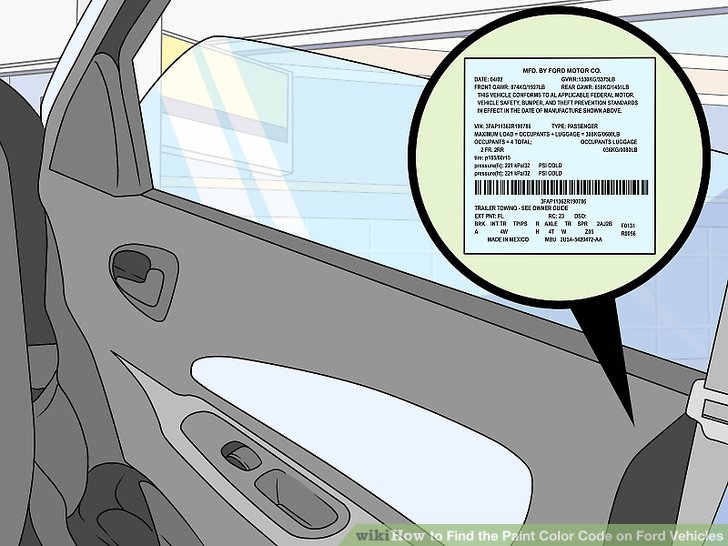Where To Find The Paint Color Of Your Car

For decades, the question "Where do I find my car's paint code?" has been a familiar one, prompting searches in glove compartments, door jambs, and under the hood. The answer, typically a sticker or plate with an alphanumeric code, has unlocked the secret to matching that perfect shade of blue, red, or silver. But as the automotive landscape rapidly evolves, driven by electric vehicles (EVs), advanced technology, and a greater focus on sustainability, even this seemingly simple query is undergoing a transformation.
The Traditional Method: A Dying Art?
While the physical sticker remains the go-to source for many, its reign is undoubtedly waning. The rise of EVs and hybrid systems introduces new complexities. Traditional paint shops, accustomed to dealing primarily with internal combustion engine (ICE) vehicles, face challenges in adapting to the unique materials and finishes used in modern EVs. Furthermore, electric vehicle paint, often designed for enhanced durability and aerodynamic efficiency, can require specialized repair techniques and color-matching processes.
Consider the increasing prevalence of multi-coat finishes, where multiple layers of paint are applied to achieve a deeper, more vibrant hue. These finishes, while visually stunning, can be notoriously difficult to replicate, even with the correct paint code. And what about the rise of custom paint jobs, often performed outside of the factory setting? The standard paint code becomes virtually useless, necessitating advanced color scanning and matching technologies.
Smart Automotive Solutions: The Digital Revolution
The future of paint code retrieval and color matching lies in the integration of smart automotive solutions. Imagine a scenario where your car's paint code is seamlessly accessible through its infotainment system or a dedicated mobile app. This information, tied to the vehicle's VIN, would be readily available to authorized repair shops, ensuring accurate color matching every time. The days of searching for a faded sticker would be over.
Furthermore, advanced color scanning technology is poised to revolutionize the repair process. Handheld scanners, connected to cloud-based databases, can analyze the precise color composition of your vehicle's paint, even factoring in environmental factors like fading and wear. This data can then be used to create a custom paint formula, guaranteeing a perfect match, regardless of the vehicle's age or condition. This is particularly beneficial for hybrid systems which often experience differing body-panel temperatures and thus, differing fade rates of paint in different areas.
The integration of artificial intelligence (AI) is also playing a crucial role. AI-powered algorithms can analyze vast datasets of paint colors and formulas, predicting the most accurate match based on a variety of factors. This not only improves the accuracy of color matching but also reduces the time and effort required to find the perfect shade. Moreover, AI can assist in identifying potential paint defects and recommending appropriate repair strategies.
Challenges and Opportunities
While the future of paint code retrieval is bright, several challenges must be addressed. Data security and privacy are paramount. Ensuring that sensitive vehicle information is protected from unauthorized access is crucial. Standardized protocols for data sharing and communication between vehicles, repair shops, and paint manufacturers are also essential. Furthermore, the cost of implementing these advanced technologies could be a barrier for smaller repair shops and individual consumers. Widespread adoption requires a collaborative effort between automakers, technology providers, and the automotive repair industry.
However, the opportunities are immense. Improved color matching leads to higher-quality repairs, increased customer satisfaction, and reduced waste. The integration of smart automotive solutions creates new business models for repair shops and paint manufacturers, fostering innovation and growth. The adoption of sustainable paint technologies, such as water-based and low-VOC paints, contributes to a cleaner environment. The development of self-healing paint coatings, capable of repairing minor scratches and abrasions, further enhances the durability and longevity of vehicle finishes.
A Visionary Note: The Future of Automotive Color
Looking ahead, the very concept of automotive paint is poised for a radical transformation. Imagine vehicles with dynamic paint finishes, capable of changing color on demand, adapting to the driver's mood or the surrounding environment. Imagine paint coatings that absorb sunlight and convert it into energy, contributing to the vehicle's range. Imagine self-repairing paint that actively heals damage, keeping your car looking pristine for years to come. The convergence of nanotechnology, materials science, and artificial intelligence is paving the way for a future where automotive paint is not just a cosmetic feature but an integral part of the vehicle's functionality and performance. The question of where to find your car's paint code will evolve into a discussion about the limitless possibilities of automotive color, a canvas for self-expression and technological innovation. We are on the cusp of witnessing a revolution in automotive aesthetics, where the boundaries between art and engineering blur, and the possibilities are as boundless as the human imagination. The vehicles of tomorrow will not just transport us; they will inspire us.
